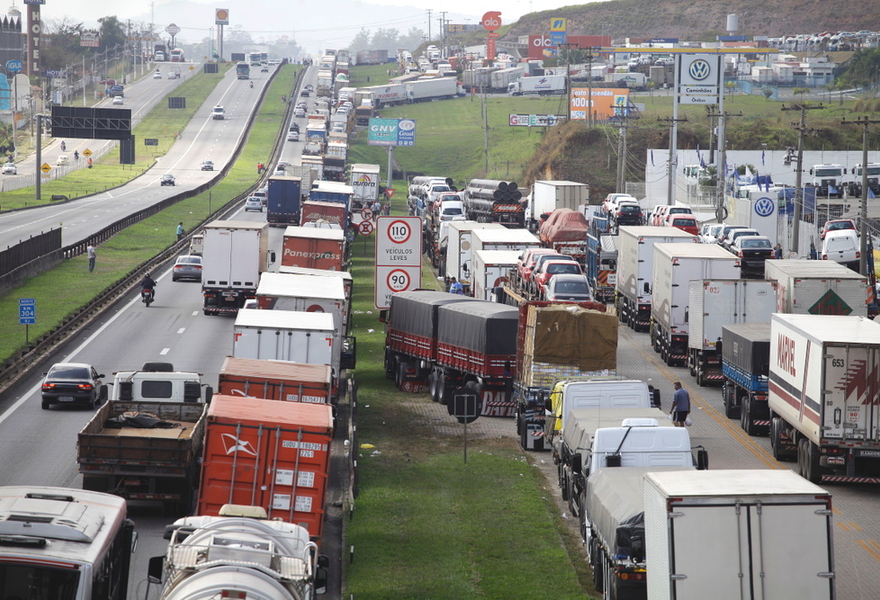The trends we need to reverse to stop global heating
Freight services, floor space, meat consumption: a new MCC-led study describes the various drivers of greenhouse gas emissions more comprehensively and precisely than ever before.

Trucks (in São Paulo, Brazil): freight transport, with 68 percent growth within two decades, is one of many reasons for the climate crisis. | Photo: Shutterstock/Antoine
Even if the coronavirus pandemic leads to a "dip" in global greenhouse gas emissions, they will continue to be high in the years to come; the drivers are intact and frighteningly strong in some sectors and regions. Despite all the political announcements to date, significant progress is not yet in sight. That is the bottom line of an unprecedented stocktake, prepared by a global research team led by the Berlin-based climate research institute MCC (Mercator Research Institute on Global Commons and Climate Change). The study has now been published in the renowned journal Environmental Research Letters.
Around 30 renowned scientists from all six continents participated in the project. "We wanted to understand the main challenges, sector by sector, for undertaking the rapid and deep transition that is now clearly needed to solve the climate crisis," says William Lamb, a researcher in the MCC working group Applied Sustainability Science and lead author of the study. "To that end, using primary data sources, we examined the trends and drivers of greenhouse gas emissions, alongside a review of the most relevant work from the research literature.”
The inventory is structured along the five major sectors of energy, industry, buildings, transport, and land use. The researchers focus on trends in these sectors and their underlying components (such as electricity generation, road transport, or livestock emissions), as well as the broad drivers economic growth, energy use, energy efficiency, and carbon intensity of different human activities. The extent to which each factor has had an impact is precisely calculated for each sector and for each world region.
According to the study, global greenhouse gas emissions increased by 11 percent from 2010 to 2018 alone. Only a few sectors saw a significant downward trend, such as the energy sector in Europe. By contrast, the particularly climate-damaging coal power generation increased in Asia. And emissions in the transport and building sectors rose in almost all regions of the world – this was in part because people in rich countries are traveling more and more and taking up more and more living space. Global freight travel activity grew by 68 percent in the last two decades. The largest emitter is the industrial sector, with 20.1 gigatonnes of CO2 equivalents worldwide in 2018, which was 35 percent of total emissions and 14 percent more than in 2010; industry-related emissions from the power sector are included here.
As much as a quarter of climate pollution comes from the often-overlooked land sector: from 1990 to 2018, humans have shrunk primary forest areas by more than 7 million square kilometres, almost as much as the size of Australia. This is often for cropland in the Global South that now produces food for Europe or China. Land use emissions are also driven by a dietary “westernisation”, with meat and internationally sourced refined products replacing traditional and seasonal produce.
"Overall, sectoral trends in the decade before the coronavirus pandemic reveal limited progress towards decarbonisation," concludes Jan Minx, working group leader at MCC and co-author of the study. "At the global level, emission reductions from technological progress were mostly outweighed by economic growth, even though a growing number of countries highlight that successful climate policy and economic competitiveness often go hand-in-hand. Keeping global heating in line with the global climate agreement will require sustainable land use, limits to excessive demand, high levels of energy efficiency, and a rapid phase-out of fossil fuels."
Reference of the cited article:
Lamb, W., Wiedmann, T., Pongratz, J., Andrew, R., Crippa, M., Olivier, J., Wiedenhofer, D., Mattioli, G., Al Khourdajie, A., House, J., Pachauri, S. Figueroa, M., Saheb, Y., Slade, R., Hubacek, K., Sun, L., Khan Ribeiro, S., Khennas, S., de la Rue du Can, S., Chapungu, L., Davis, S., Bashmakov, I., Dai, H., Dhakai, S., Tan, X., Geng, Y., Gu, B., Minx, J., 2021, A review of trends and drivers of greenhouse gas emissions by sector from 1990 to 2018, Environmental Research Letters
https://iopscience.iop.org/article/10.1088/1748-9326/abee4e





